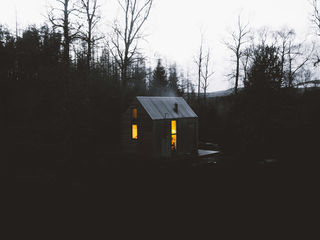Midlife
Taking to the Hut at Midlife
A silent solitary retreat might be exactly what a midlife person needs.
Posted June 5, 2017

Midway along the journey of our life
I woke to find myself in a dark wood,
for I had wandered off from the straight path
(Dante Alighieri, Inferno, Canto I)
The midlife invitation
There is a myth in this culture that psychological development hits a plateau at some point—usually some point during young adulthood—and then keeps chugging along, business as usual, until the inevitable decline of our elderly years. We tend to think that once we have built an identity and secured a place in our communities, we have completed the primary psychological task in this life: to know who we are and to assume our proper role in society. This unspoken narrative frames and guides the experience of so many in this culture.
Despite the plateau narrative, many people struggle during their midlife years and find themselves fumbling through a “dark wood”—in a strange new world, without a guide to help them navigate the discomfort and disorientation and create something meaningful out of the experience. I believe that the midlife transition—which is more psychological than chronological, but nonetheless tends to occur for people between the ages of 35 and 55—is a very real invitation to greater and deeper life.
Many midlife individuals find themselves asking “Is this all there is?” “Why doesn’t my life feel truly meaningful and satisfying, despite my obvious accomplishments?” “Why do I feel stuck, vaguely depressed, or itchy and irritable for no clear reason?” These questions are invitations, but many people decline the invitation and anesthetize their discomfort with chronic busyness, television, the Internet, food, alcohol, geographic relocation, hyper-consumption, sexual affairs, or good old-fashioned denial. This too often leads to a devitalized existence in which the individual clings to a life they’ve long outgrown.
The second half of life can be lived well, but not if you cling to the forms of identity and modes of being learned and mastered in the first.
Taking to the hut at midlife
There is wisdom in the symptom. The discomfort that accompanies midlife is trying to tell you something. But in order to discern the message, you have to stop and listen. Embarking on a silent, solitary hermitage-style retreat can provide you with a unique opportunity to do just that.

Though our youth-oriented culture lacks rituals and containers for people undergoing the midlife transition, creative midlifers can utilize a hermitage as a temporary container, or chrysalis, as they shed their old skin and make space for something new. In the lengthy, open-ended stretches of time and deep silence available to you, what might emerge? With very few distractions, no social roles to perform, and no people around to remind you of who you are in the world—in other words, of the self you spent the first half of your life constructing—what new experience of self and world might become possible? What new life wants to come through, and what old forms of identity and modes of being need to die? These are the important questions, and these questions can only be engaged with if you sit. Literally. Sit. You need to slow down, quiet down, and sit still long enough to listen.
In the beginning of your retreat, you may only hear the chattering of your own mind and observe your automatic efforts to distract yourself from being present, and this in and of itself might be a revelation. A life review process might then transpire, memories may flood in, and emotions long buried may resurface. But if you continue to listen, hour after hour, day after day, something else beyond the personal material accumulated from the first half of life may begin to reveal itself in the clearing you’ve created.
I don’t mean to be cryptic here about what can happen during a solitary retreat. I’m being intentionally vague because each retreatant discovers something different in their solitude. The overarching point is that they’ve designated a sacred space in which to become present to the good, the bad, and the ugly and are bravely attending to the “warts and all” of their experience. This attention may be the greatest gift they can give to themselves in this fast-paced, hyper-stimulated, and chronically distracted world—a world in which solitude (especially women’s solitude) is still largely considered taboo, unhealthy, or unnatural.
So find a hermitage, a hut, some simple space, perhaps on the grounds of a monastery (you need not be religiously affiliated to stay there), or perhaps just rent someone’s rustic cabin in the woods in rural Tennessee and designate it as your sacred space. Leave behind your phone and computer. Maybe unplug the clock and cover the mirror in the bathroom. If you’re super courageous, don’t even bring books (this may prove the most challenging!). Then just sit. Wait. Walk in the woods. Look at trees. Sit some more. Drink some tea. See what unfolds. Wrestle with your withdrawal from everyday stimulants and social contact. One day will probably feel like 10 days, at least at first. Keep listening. Keep looking. Keep waiting.
What might emerge in the silence of your hut? What are you being called to in this new phase of your life? I cannot tell you. You must go and see for yourself.


